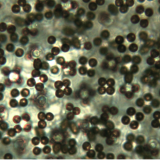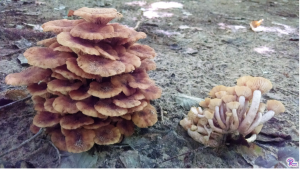#181: Chlorophyllum molybdites
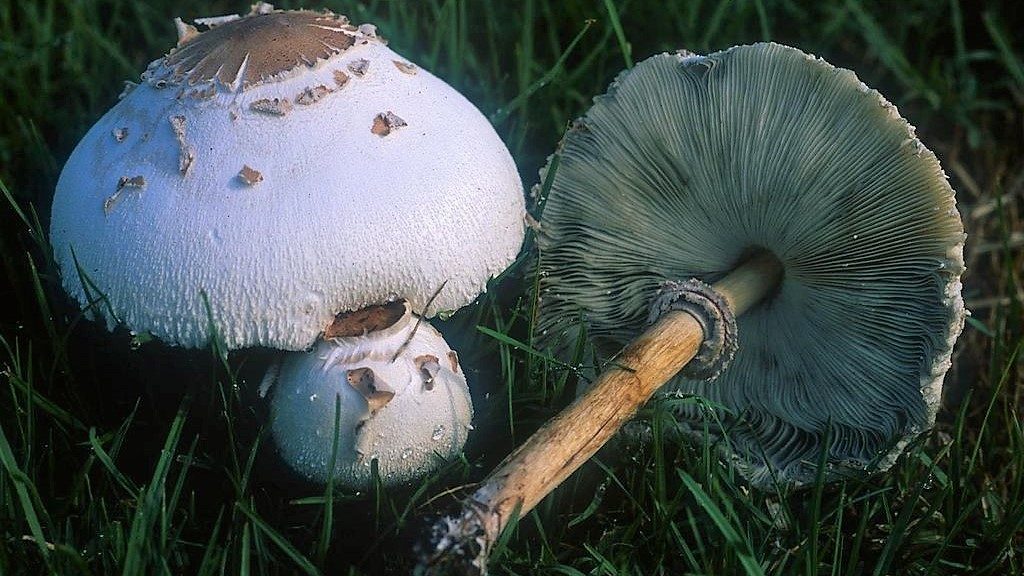
Chlorophyllum molybdites is known for its large scales, greenish gills, thick ring, and slightly enlarged base. Photo by Nathan Wilson [CC BY-SA 2.5], via Wikimedia Commons
Description
As hinted at by its common names, C. molybdites is a lepiotoid mushroom (FFF#???): it has a circular pileus, a central stipe, free gills, and a partial veil. C. molybdites is large for a lepiotoid mushroom, growing 5-25cm tall and 5-30cm wide.3–5
The pileus of C. molybdites is fairly distinctive. When young, it is spherical and pinkish to brownish, but as the mushroom grows the outer layer cracks apart to reveal a white surface below. Mature mushrooms have a pileus that is convex to flat, white, and dotted with pink to brown scales. The scales are irregularly distributed across the pileus and the spacing usually decreases toward the center, where they coalesce to form a solid disc of darker tissue.3–5
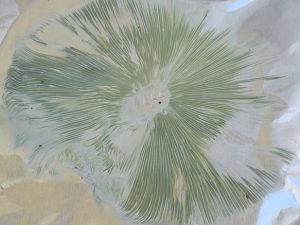
Green spore print of C. molybdites. Photo by Byrain at Mushroom Observer [CC BY-SA 3.0], via Wikimedia Commons
For supporting such a large pileus, the stipe is surprisingly thin and dainty. It is white and sometimes features tiny hairs or scales. The stipe is equal in width for the most part, but often tapers slightly toward the top and expands slightly toward the base. Near the top of the stipe, you will find the most interesting feature of the stipe: the ring. Before the mushroom’s gills are ready to produce spores, they are covered with a thick, white membrane called a partial veil. As the mushroom matures, the membrane breaks apart and exposes the gills. The bulk of the partial veil collapses around the stipe to form the ring; a few remnants may also be found clinging to the edge of the pileus. The ring is thick and persists well into maturity.3–5
Ecology
C. molybdites is a common sight in North American meadows and lawns from spring through fall.3–5 I usually find these mushrooms during hot weather following heavy rain. For my area, this means I am most likely to find them in September and October, although they can fruit during other months as well.
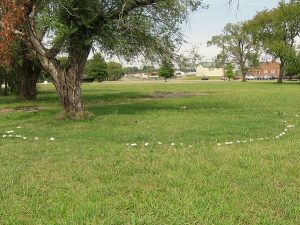
C. molybdites often makes fairy rings in lawns. Phot by Brian Adamo (adamo588) at Mushroom Observer and Ak cmm [CC BY-SA 3.0], via Wikimedia Commons
Although the Green Spored Lepiota can produce a solitary mushroom, it is more likely to produce several mushrooms in a small area. The fungus also frequently pushes up mushrooms in a fairy ring.1,4 This ecology is particularly well suited to suburbia, and this mushroom commonly pops up in peoples’ yards. Unfortunately, this raises the likelihood that someone will accidently eat it.
Toxicity
The Green Spored Lepiota is the worst GI irritant mushroom. In fact, the symptoms are different enough from those produced by other GI irritant mushrooms that the North American Mycological Association’s webpage on mushroom toxins lists C. molybdites separately (see this page).2 Symptoms appear between one and two hours after eating the mushroom and can include: nausea, dizziness, vomiting, abdominal pain, and diarrhea. These symptoms can vary in severity due to differences in weather, individual mushrooms, and each person’s age and sensitivity.6 In the worst cases, sufferers can have bloody, explosive diarrhea and may need hospital treatment. The toxin(s) involved are not yet known, so treatment of C. molybdites poisoning focuses on alleviating symptoms: doctors administer drugs to counteract the vomiting and diarrhea and administer fluids and electrolytes when necessary. One of the greatest dangers with this type of poisoning is dehydration, so staying properly hydrated is paramount. The only known fatality from the Green Spored Lepiota was a child, which is not surprising because children are more likely to eat unknown mushooms and because they are smaller and therefore more sensitive to toxins than adults are.1,6
Similar Species
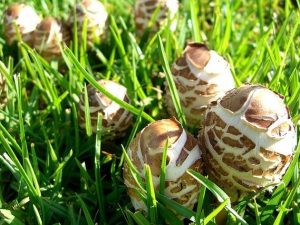
When young, C. molybdites is nearly impossible to tell apart from other Chlorophyllum species. Photo by Jason Hollinger [CC BY 2.0], via Wikimedia Commons
Parasol Mushrooms like Macrolepiota procera can also be confused the Green Spored Lepiota. M. procera (the “Parasol Mushroom”), or whatever version of that species exists in America, can be distinguished by its snakeskin-like pattern on the stipe and its usual preference for forest habitats. Still, it is close enough in appearance that you should check to make sure your specimen does not have green spores.4
Some Amanita species also resemble C. molybdites,4 but no amanitas produce green spores. Additionally, the bumps of tissue on top of an Amanita pileus slough off easily whereas the scales of C. molybdites are attached to the pileus.
Taxonomy
You may have noticed the word ‘chlorophyll’ in the name Chlorophyllum molybdites. There is a good reason for this: chlorophyll is derived from the words ‘chloro’ meaning ‘green’ and ‘phyllum’ meaning leaf.1 Chlorophyll is so named because it is the substance that turns plant leaves green. Similarly, the name Chlorophyllum denotes the green gills of C. molybdites (taxonomists don’t have a separate word for ‘mushroom gills’, so they just use the word for ‘leaves’).
The classification of C. molybdites, like that of many agarics, has changed a lot over the years. Most significantly, it once belonged to the genus Lepiota.7 Its common name – the “Green Spored Lepiota” – was established at that time. The name used publicly for this mushroom has not changed since, even after mycologists reassigned it to Chlorophyllum. C. molybdites is now just one of a multitude of mushrooms whose common names reflect outdated taxonomy.
| Kingdom | Fungi |
| Division | Basidiomycota |
| Subdivision | Agaricomycotina |
| Class | Agaricomycetes |
| Subclass | Agaricomycetidae |
| Order | Agaricales |
| Family | Agaricaceae |
| Genus | Chlorophyllum |
| Species | Chlorophyllum molybdites (G. Mey.) Massee7 |
This post describes a group of mushrooms and as such the information on this page (including the pictures) cannot be used to identify any mushroom in particular.
This post does not contain enough information to positively identify any mushroom. When collecting for the table, always use a local field guide to identify your mushrooms down to species. If you need a quality, free field guide to North American mushrooms, I recommend Michael Kuo’s MushroomExpert.com. Remember: when in doubt, throw it out!
Do not use information in this post to self-diagnose or self-treat a medical complaint. Always consult a licensed medical doctor for proper diagnosis and treatment of a health issue.
See Further:
http://botit.botany.wisc.edu/toms_fungi/aug99.html
http://www.mushroomexpert.com/chlorophyllum_molybdites.html
http://www.mykoweb.com/CAF/species/Chlorophyllum_molybdites.html
http://www.rogersmushrooms.com/gallery/DisplayBlock~bid~5729.asp
Citations
- Volk, T. J. Tom Volk’s Fungus of the Month for August 1999. Tom Volk’s Fungi (1999). Available at: http://botit.botany.wisc.edu/toms_fungi/aug99.html. (Accessed: 17th March 2017)
- Mushroom Poisoning Syndromes. North American Mycological Association Available at: http://www.namyco.org/mushroom_poisoning_syndromes.php#misc. (Accessed: 17th March 2017)
- Phillips, R. Chlorophyllum molybdites Mushroom. RogersMushrooms Available at: http://www.rogersmushrooms.com/gallery/DisplayBlock~bid~5729.asp. (Accessed: 17th March 2017)
- Kuo, M. Chlorophyllum molybdites. MushroomExpert.Com (2015). Available at: http://www.mushroomexpert.com/chlorophyllum_molybdites.html. (Accessed: 17th March 2017)
- Wood, M. & Stevens, F. California Fungi—Chlorophyllum molybdites. The Fungi of California Available at: http://www.mykoweb.com/CAF/species/Chlorophyllum_molybdites.html. (Accessed: 17th March 2017)
- Espinoza, L. & Smith, M. E. The Green-Spore Poison Parasol Mushroom, Chlorophyllum molybdites. University of Florida IFAS Extension (2016). Available at: http://edis.ifas.ufl.edu/pp324. (Accessed: 17th March 2017)
- Chlorophyllum molybdites. Mycobank Available at: http://www.mycobank.org/BioloMICS.aspx?TableKey=14682616000000067&Rec=42094&Fields=All. (Accessed: 17th March 2017)

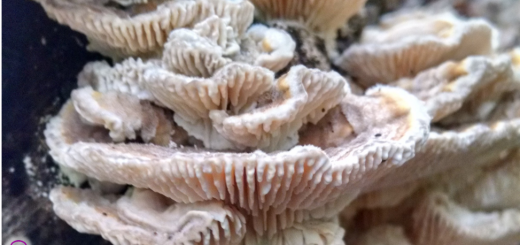






![#011: Characteristics of Kingdom Fungi [Archived]](https://www.fungusfactfriday.com/wp-content/themes/hueman/assets/front/img/thumb-small-empty.png)
